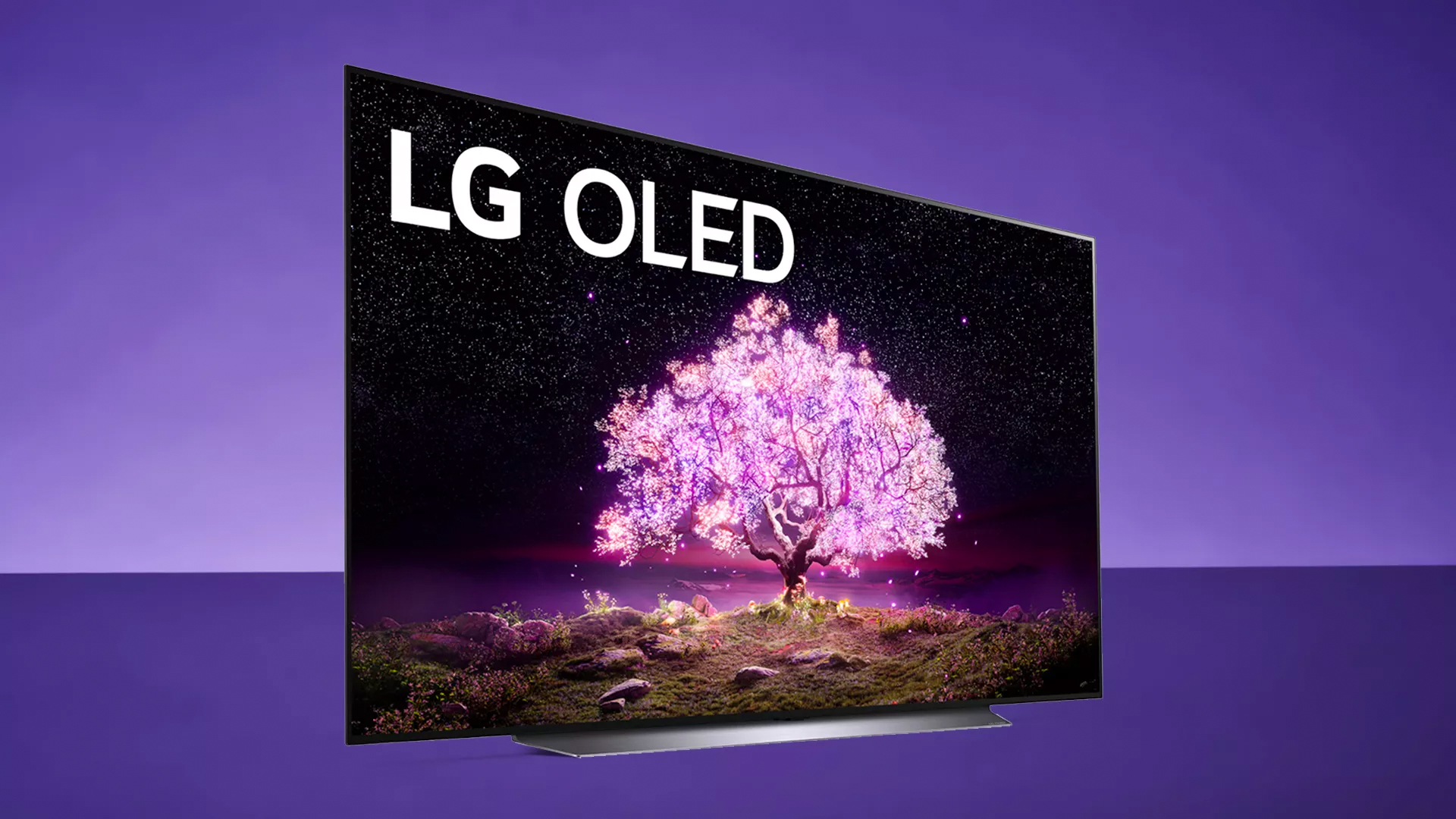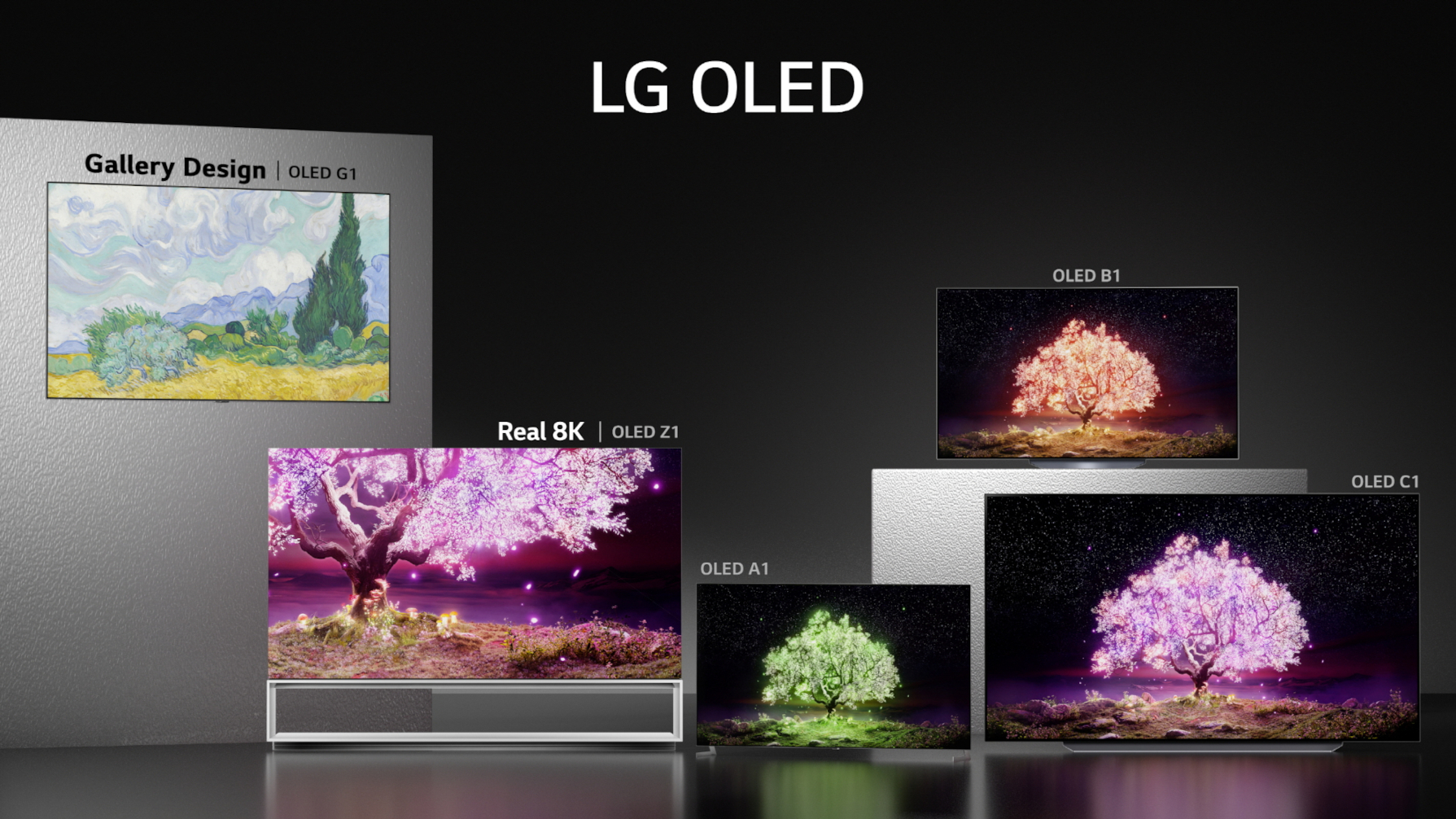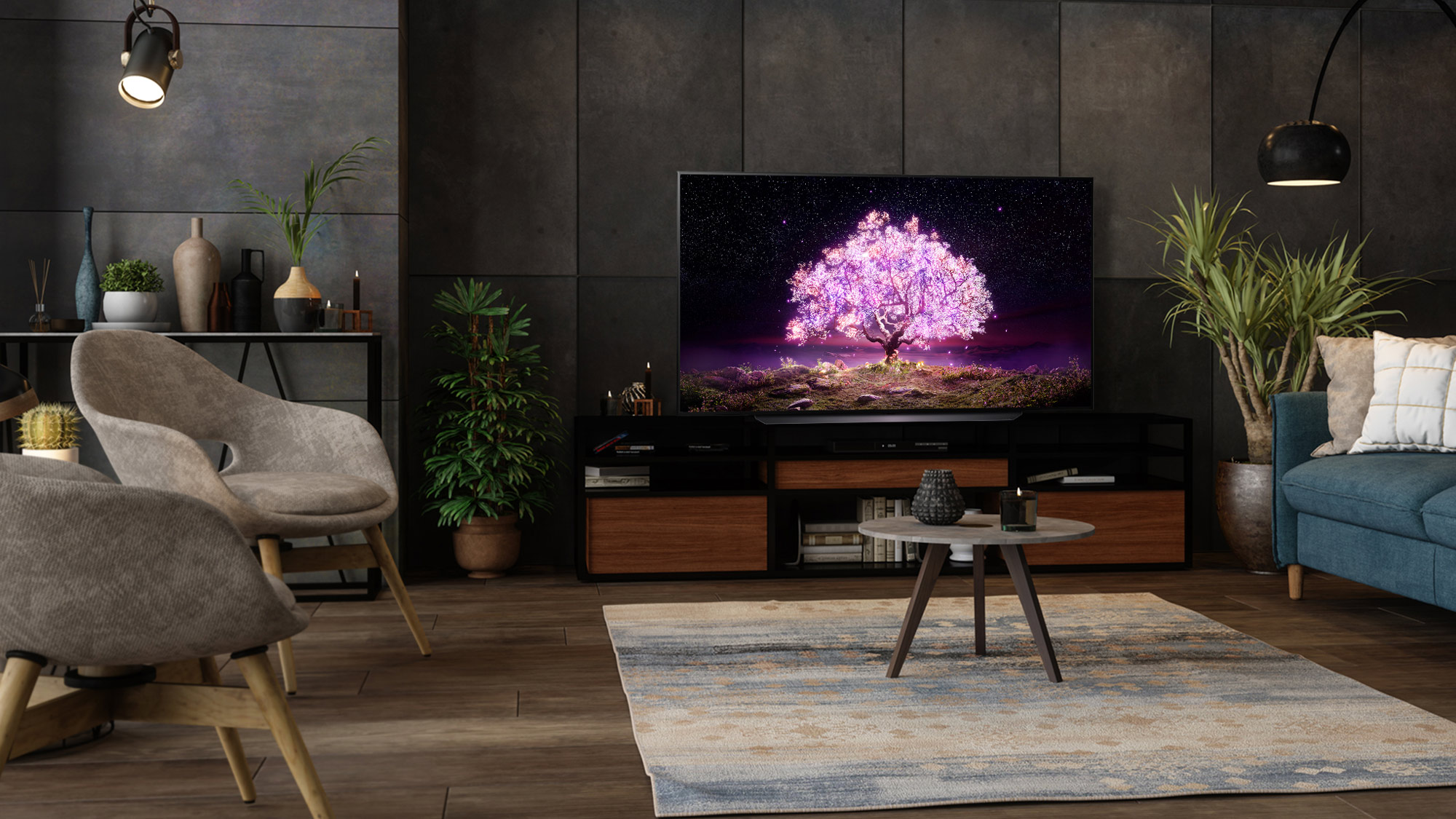LG 2021 OLED TVs compared: Which one should you buy?

When it comes to OLED technology, the brand that matters most is LG. Sure, there are OLED TVs being sold by other companies, like Sony and Vizio, but the undisputed leader in OLED is LG, and the most anticipated 4K OLED TVs all come from the same company.
We got our first look at the new OLED models in the LG 2021 TV lineup, but with LG's latest OLED TVs hitting the market in the coming weeks, one question is the most important for many TV shoppers: How do these new LG OLEDs stack up against each other, and which one is best for me?
Editor's Note: March 25, 2021 LG has announced pricing for its 2021 OLED TVs, and we've updated this article to reflect the new information.
- Check out the best TVs we've reviewed
- TV buying guide: Tips to choose your ideal TV
- LG 2021 TV Lineup: OLED Evo, QNED with Mini LED, 8K, 4K and more
We've looked at the specifications, we've detailed the features and we've made the best guesses about pricing that we can make. Our LG C1 vs G1 vs A1 comparison has everything you need to make an informed decision.
LG 2021 OLED TVs: Clearing up category confusion
Perhaps more in 2021 than any other time, LG is dividing its OLED lineup into three specific categories. You have the most premium model, the LG Gallery G1 OLED, the mainstream LG C1 OLED, and (new for 2021) the entry-level A-Series, with the budget-friendly LG A1 OLED TV.
There's still a few things we don't know, such as specific pricing, but based on existing information about product specs and market positioning, it's clear that LG has taken steps to differentiate these three OLED TVs more clearly than past OLED models.
And we're glad they have. In our recent LG GX OLED TV review, we noted that because it used the same OLED panel and video processing that we saw in our LG CX OLED TV review, the performance was nearly identical, and it was hard to justify the higher price for the more premium Gallery series TV.
Get instant access to breaking news, the hottest reviews, great deals and helpful tips.
Similarly, in our LG BX OLED TV review, there were some notable differences between the budget-friendly model and the LG CX OLED, but many aspects of the design and feature set were so closely matched that some shoppers might actually get confused about which model they were looking at.

LG 2021 OLED TVs: Different by design
The newest LG OLED TVs aim to correct this category confusion, with more distinct differences between the three pricing tiers that the OLED models fall into.
| Header Cell - Column 0 | LG G1 OLED | LG C1 OLED | LG A1 OLED |
|---|---|---|---|
| Screen sizes | 55, 65, 75 inches | 48, 55, 65, 77, 83 inches | 48, 55, 65, 77 inches |
| Design | Gallery | Pedestal | Dual feet |
| Price | $2,199 - $4,499 | $1,499 - $5,999 | $1,299 - $3,199 |
At the top is the premium LG G1 OLED, which uses LG's Gallery design for a distinctive look and easy wall-mounting. Measuring just 20 mm thick and utilizing a flush-fit wall mount, complete with proprietary mounting hardware that is recessed into the back of the TV, it is the sleekest member of the LG OLED family.
The LG C1 OLED utilizes a more traditional TV design, with a pedestal base and LG's familiar display-on-glass aesthetic, which takes advantage of the incredibly slim requirements for an OLED panel, making for an incredibly slim TV design. It's not only LG's most mainstream set in terms of price and features, it also has the widest range of screen sizes, from a compact 48-inch set up to a whopping 83-inch big screen OLED – the largest we've seen without upgrading to 8K resolution.
The LG A1 OLED, by comparison, is one of the least sophisticated looking OLED designs we've seen. Instead of the stylish pedestal base scene on sets like the LG CX and BX OLEDs, the LG A1 has feet that attach, putting it much more in line with more affordable models in LG's non-OLED lineup.
But the differences extend far beyond the physical design of the TV. With unique options in panel quality, processor, sound system, and smart features, the premium, mid-range, and budget OLED TVs offer clear differentiation from one model to the next.
So let's look at the specifications and features of each to see how they add up.
LG C1 vs G1 vs A1 OLED TVs: Specs
When it comes to specifications, we see some pretty diverse features offered across this trio of OLED TVs.
| Header Cell - Column 0 | LG G1 OLED | LG C1 OLED | LG A1 OLED |
|---|---|---|---|
| Panel type | OLED evo Display | OLED 4K | OLED 4K |
| Refresh rate | 120Hz | 120Hz | 60Hz |
| Processor | α9 Gen 4 | α9 Gen 4 | α7 Gen 4 |
| Audio | 4.2 Ch / 60W | 2.2 Ch / 40W | 2.0 Ch / 20W |
| HDMI ports | 4 HDMI 2.1 | 4 HDMI 2.1 | 3 HDMI 2.0 |
The display options are no longer a single OLED 4K panel, with LG introducing its new LG OLED evo technology exclusively on the G1. With a new luminous element and re-formulated organic compounds, the OLED evo display promises higher brightness and more precise color than the standard 4K OLED panel used on the C1 and A1 TVs. (Learn more in our article LG unveils OLED evo TVs — here’s what makes it better.)
Refresh rates are also a point of divergence, with the higher tier G1 and C1 models boasting the 120Hz refresh rates we recommend most, and the A1 getting a more pedestrian 60Hz display. While this is adequate for most content and gaming, the latest advancements – like the latest PS5 and Xbox Series X consoles and some digital media sources – are already leaving 60Hz refresh rates behind.
Processing power is also reduced on the A1 OLED, with it getting LG's 4th generation Alpha 7 processor instead of the more capable Alpha 9 chip used in the C1 and G1 models. While the majority of content will look and sound the same between the two processor options, you may notice that the more premium Alpha 9 chip leaves video looking a little better in some scenes, thanks to new capabilities like scene detection, which applies a number of tweaks based on the type of scene being shown, whether it's day or night, city or landscape, action or dialogue.
Audio will be a far bigger sticking point for some shoppers, as the premium G1 gets 4.2-channel sound with potent 60-watt speakers, the mid-range C1 steps down to 2.2-channel sound with 40-watt speakers, and the budget A1 OLED drops to a very basic set of stereo speakers with only 20-watts of power.
The other big difference is in port selection. Both the G1 and C1 models will boast four HDMI 2.1 ports, offering full support for higher refresh rates and better gaming, while the A1 OLED has only 3 ports, and scales them back to HDMI 2.0. It will still support 4K playback for Blu-ray players and game consoles, but it's capped at 60Hz.

LG 2021 OLED TVs: Features
Other features are split between the three OLED models along similar lines, with the slick G1 OLED offering the most capability, the value-priced A1 OLED offering the least, and the mainstream C1 OLED sitting between the two like Baby Bear from Goldilocks, with a mix that most shoppers will find just right.
| Header Cell - Column 0 | LG G1 OLED | LG C1 OLED | LG A1 OLED |
|---|---|---|---|
| Hands-free voice control | Y | N | N |
| Magic Tap remote | Y | N | N |
| ATSC 3.0 tuner | Y | N | N |
| eARC | Y | Y | Y |
| Dolby Vision | Y | Y | Y |
| Dolby Atmos | Y | Y | Y |
| WiSA support | WiSA ready (5.1) | WiSA ready (5.1) | WiSA ready (2.0) |
Features that are exclusive to the G1 OLED include hands-free voice control, LG's new Magic Tap remote and a built-in ATSC 3.0 tuner. The interesting thing about these exclusive features is that many people won't be too broken up about missing them.
Hands-free voice control is nice, letting you use the TV like an Amazon Echo or Google Home smart speaker to access the Alexa and Google Assistant voice assistants, and issue voice commands without having to speak into the mic on the remote control. But that capability also requires far-field microphones that listen to the room and are always on (unless manually disabled), and that level of invasiveness from a TV has put off shoppers in the past. Smart speaker fans might not be as worried about LG listening in on their conversations, but a fair number of shoppers will actually prefer a TV without the built-in mics.
LG's Magic Tapo remote is another interesting convenience, placing an NFC tag in the remote control for easy one-touch pairing with a smartphone. That capability isn't unique to this TV or even to LG, but the idea of putting that touch point into the remote instead of the TV frame adds some ease of use. Who wants to get up off the couch when you want to share content from your phone? But mobile sharing features are already among the less used features on many smart TVs, and this one tweak isn't likely to sell anyone on the more expensive G1.
Lastly, the G1 OLED is one of the only TVs on the market with an ATSC 3.0 tuner. While NextGen TV (ATSC 3.0's official name) is rolling out to different cities across the country, it's still early days, even if it does offer the chance to get free 4K over-the-air programming.
The other big difference between the three is in support for WiSA, a wireless standard for audio that offers seamless multi-channel audio without plugging in a single audio cable. It's a very cool feature that's offered on all three OLED sets, but the A1 OLED only offers it for 2-channel systems. The G1 and C1 models, on the other hand, offer 5.1 WiSA support, which is much more in line with the use-case of the average WiSa user.

LG 2021 OLED TVs: Gaming support
The other major difference between the A1 OLED and the more expensive C1 and G1 models is gaming. With many gamers eager to elevate their gaming experience with an OLED TV, it would make sense that the least expensive of these premium TVs would garner the most interest from the gaming faithful. Unfortunately, of the three 2021 LG OLED model lines, the A1 OLED is missing some of the most important gaming features.
| Header Cell - Column 0 | LG G1 OLED | LG C1 OLED | LG A1 OLED |
|---|---|---|---|
| ALLM | Y | Y | Y |
| VRR | Y | Y | N |
| Nvidia G-Sync | Y | Y | N |
| AMD FreeSync | Y | Y | N |
The biggest difference is one we touched on earlier, the move to fewer HDMI ports, and the decision to equip the A1 OLED with HDMI 2.0 instead of the more current 2.1 standard. That automatically rules out support for higher frame rates on the PS5 or Xbox Series X, which both offer 4K gaming at 120Hz.
The loss of an HDMI port also means you'll have to manually swap connections if you want to add another box to your home theater/gaming setup. If you have more than one HDMI-connected console, even if it's just a Nintendo NES Classic Mini, you'll be unplugging and plugging by hand whenever you want to switch to a different console.
But the move to HDMI 2.0 means you'll also give up the most impressive and current gaming features, like variable refresh rates (VRR) and support for PC gaming with Nvidia G-Sync and AMD FreeSync. The one feature you will get is auto low-latency mode (ALLM), which detects when you're switching to a game on a console and switches to the game mode on its own.
The result is a TV that may be great for movie watching and channel surfing, but lacks many of the features gamers would specifically want to enjoy. We obviously haven't tested the upcoming TVs for gamer-oriented performance numbers like lag time, so the A1 OLED may still be very capable for casual gamers who aren't picky about frame rates or PC support.
For our money, if you want a budget-friendly OLED that has full support for features like VRR and 120Hz games, the LG's 2020 OLEDs may be a better fit. The LG CX OLED will be dropping in price as the new sets reach stores, and last year's LG BX OLED was not only equally affordable, it also had HDMI 2.1 connectivity.

LG 2021 OLED TVs: Pricing
Aside from design and specs, the other major difference between these three model lines is price. LG has not officially announced US pricing yet, but we can make some educated guesses based on the pricing of the 2020 models, as well as early rumors about 2021 pricing.
We will update this section as new pricing details are made available, but we already know enough to have a good idea of where each set will sit in terms of price, and how they might fit into the average TV shopper's budget.

The LG G1 OLED TV is LG's top-of-the-line 4K OLED smart TV, aimed at premium customers, and it will definitely be the most expensive of the three. The 2020 model seen in our LG GX OLED TV review started at $3,499 for the 65-inch model, and ranged from $2,499 for the 55-inch size up to $5,999 for the largest 77-inch model. That's pricey even for OLED, with the 2020 GX OLED priced higher than any other 4K smart TV we reviewed all year.
The new 2021 models will be selling for $3-500 less across the board, all while offering the same premium design and features and boasting LG's new OLED evo technology. It's still a premium price, but it's fair bit more affordable than last year.
| Model number | Screen size | Price | Availability |
|---|---|---|---|
| OLED55G1PUA | 55 inch | $2,199 | April |
| OLED65G1PUA | 65 inch | $2,999 | Available now |
| OLED77G1PUA | 77 inch | $4,499 | Available now |

The LG C1 OLED TV is LG's mid-range OLED TV, with the most mainstream collection of features and widest number of screen size options available. The 2020 65-inch model seen in our LG CX OLED TV review initially sold for $2,799, and with a 55-inch model selling for $1,799 and the larger 77-inch CX OLED priced at $4,999. A 48-inch model was released later in 2020 for $1,499.99.
The new C1 OLED models are less expensive, selling for $2-300 less than LG's 2020 models. The 65-inch C1 OLED, for example, will sell for $2,499 (a $300 price drop), and the 77-inch C1 will start at $3,799, down from the $4,999 of the same sized 2020 model.
That said, the smaller 48-inch OLED is unchanged in price, and the 55-inch C1 is selling at the same $1,799 price that the 2020 CX OLED sold for.
And there's a new bigger and more expensive member of the family for 2021, the 83-inch C1 OLED, which will sell for $5,999. That's a pretty premium price even for the size.
| Model number | Screen size | Price | Availability |
|---|---|---|---|
| OLED48C1PUB | 48 inch | $1,499 | April |
| OLED55C1PUB | 55 inch | $1,799 | March |
| OLED65C1PUB | 65 inch | $2,499 | March |
| OLED77C1PUB | 77 inch | $3,799 | March |
| OLED83C1PUB | 83 inch | $5,999 | May |

Finally, there's the LG A1 OLED TV, a budget-priced set that LG clearly wants to position as an entry-level option, but also as the value OLED of 2021. It's a position that has more competition than ever before, thanks to the Vizio OLED TV, which has reset the bar for affordability in the OLED space. Vizio's 55-inch model has a regular price of $1,299, but has dipped below the $1,000 mark during recent major sales for Black Friday and Super Bowl weekend.
We don't have anything to compare the LG A1 OLED to for historical pricing information, but LG has announced pricing for the new entry-level sets. The LG A1 OLED will start at $1,299 – for the 48-inch model. That's a bit of a letdown, seeing as both the 55-inch Vizio and LG BX OLED sell for $1,299 in the larger 55-inch size.
But TV prices trend down over the course of a year, and these prices aren't sky high to begin with. There's still reason to hope that the A1 will be the first OLED TV to retail at a sub-$1,000 price point later this year, whether that's due to sales discounts or regular price changes.
| Model number | Screen size | Price | Availability |
|---|---|---|---|
| OLED48A1PUB | 48 inch | $1,299 | June |
| OLED55A1PUB | 55 inch | $1,599 | April |
| OLED65A1PUB | 65 inch | $2,199 | April |
| OLED77A1PUB | 77 inch | $3,199 | June |
LG C1 vs G1 vs A1: Which LG OLED TV will be best?
While all three 2021 LG OLED TVs have a lot to offer, from the premium LG G1 OLED to the entry-level LG A1 OLED, judging by the specs and features we know about, it seems clear that the LG C1 OLED TV will be the LG 4K OLED model that most shoppers will prefer. The LG C1 OLED offers the best blend of features and capabilities, from the excellent picture quality of OLED to the specifics of HDMI 2.1 and gaming support.
The cheaper LG A1 OLED may come in at a more affordable price, but there are real compromises made for that affordability. The more premium LG G1 OLED may boast some impressive features and cool capabilities, but even with lower prices than last year it's all but guaranteed to be expensive enough that most shoppers will give it a pass.
Brian Westover is currently Lead Analyst, PCs and Hardware at PCMag. Until recently, however, he was Senior Editor at Tom's Guide, where he led the site's TV coverage for several years, reviewing scores of sets and writing about everything from 8K to HDR to HDMI 2.1. He also put his computing knowledge to good use by reviewing many PCs and Mac devices, and also led our router and home networking coverage. Prior to joining Tom's Guide, he wrote for TopTenReviews and PCMag.

